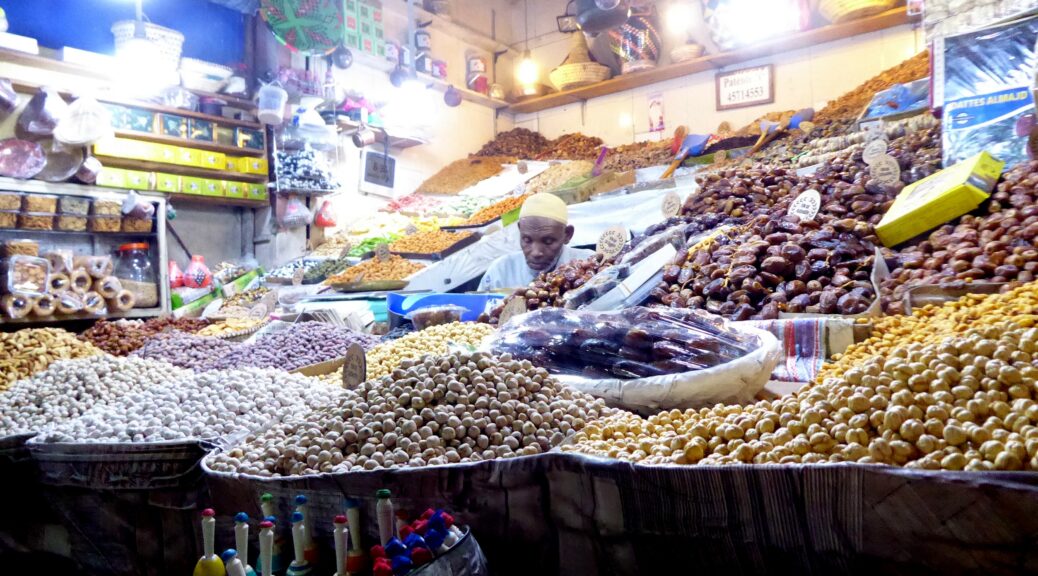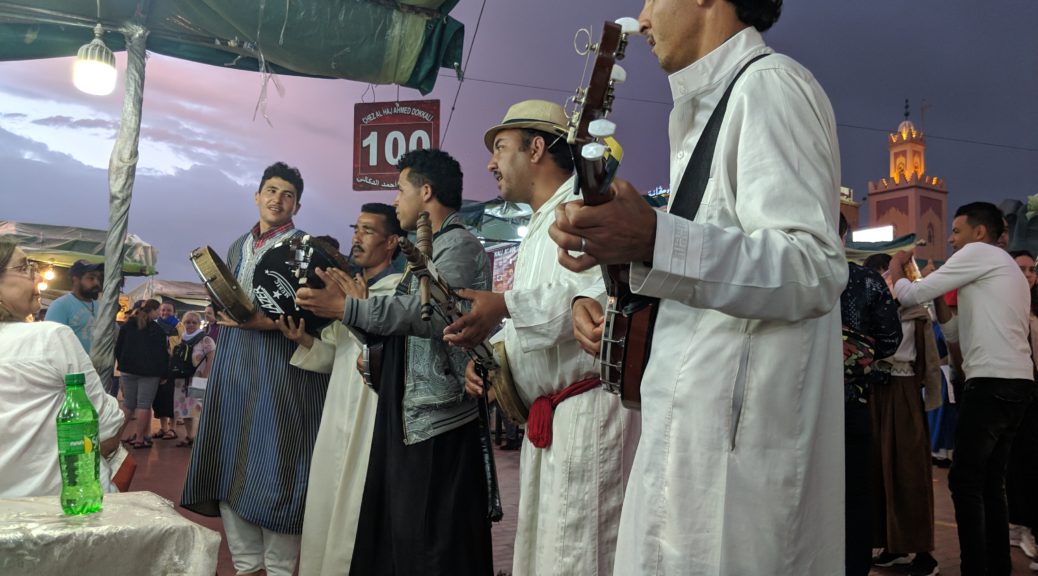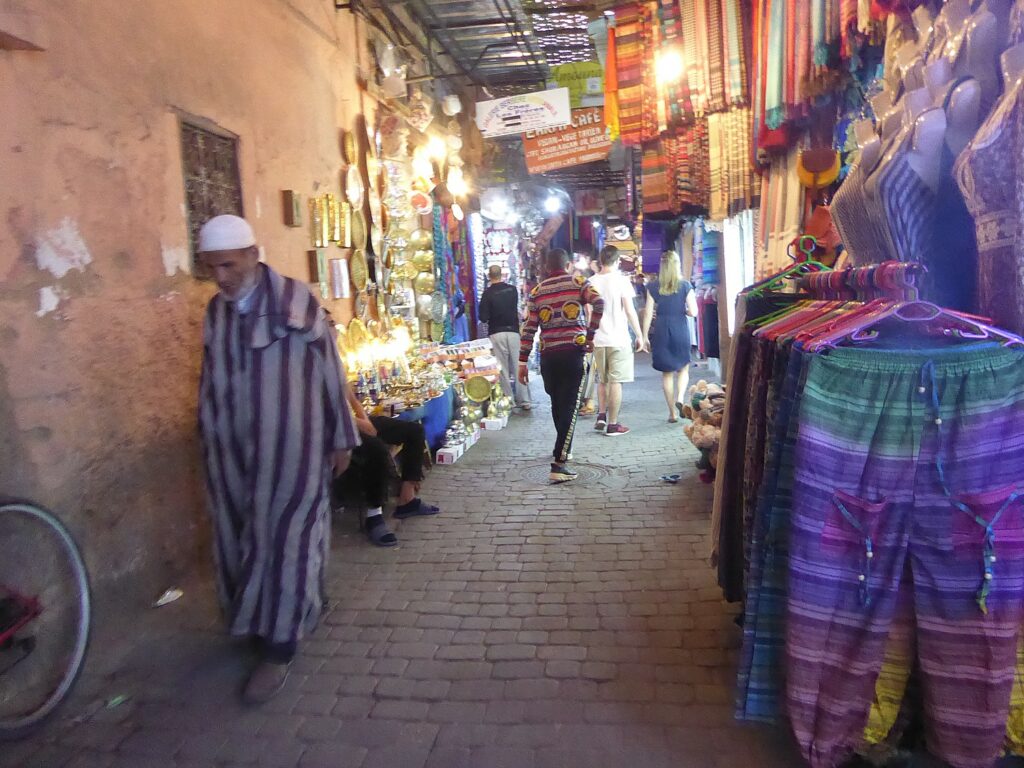
by Karen Rubin, Travel Features Syndicate, goingplacesfarandnear.com
Bill Chalmers, the “ringmaster” and CEO (Chief Experience Officer) of the Global Scavenger Hunt, launches us our biggest, most ambitious and difficult leg of the 23-day, around-the-world mystery tour: a Par 6, in which our challenge is to get from Marrakesh through four countries – Morocco, Gibraltar, Spain and Portugal with scavenges in each to win points – in five days, meeting at 11:30 am in Porto, Portugal, when we will fly out to New York, our final destination and the final and decisive leg of the competition to be crowned “World’s Best Traveler”.
“Now for your final exam, when all the skills you have learned come together while your situational awareness is peaking and the Travel IQ ready for action,” Chalmers tells us as we gather together in the lobby of the Savoy Le Grand in Marrakesh, Morocco. “The Big multi-country adventure of the Par 6 North Africa/Iberian Peninsula leg.
“There are over 150 scavenges with 19 Bonuses, 3 Team Challenges and a whole lotta good eating; six exciting days of buses, trains, ferries, camels, trams, bikes and funiculars; four diverse country stops over 1,400 km (870 miles) lay between here in Marrakesh and there in Porto. Oh yea, did I mention May Day!?”
Teams are handled $300 to cover their best-guess transportation costs and told we are required to secure our own lodgings for three nights (we are given an allowance of $200 per team per night) “all depending on your risk/reward course of action. We will see you Friday at 11:30AM in the lobby of our Porto, Portugal hotel. Good luck to everyone, be safe, be smart.”
Chalmers allows these rule changes for this climatic leg:
1) Teaming up allowed, but only in Morocco!
2) Car rentals allowed, but only once, and only within one single country where
the rental must be both picked-up & returned.
3) Use of smartphones allowed.
4) Airbnb & Uber allowed.
There are some 150 scavenges in this leg (a challenge is to figure which ones to do for points and logistics), including mandatory ones like #51 (“Within the bowels of Fes el-Bali, visit the Baab Bou Jeloud gate”). It is also mandatory to complete at least one scavenge in all four primary countries: Morocco, Gibraltar, Spain and Portugal. Other mandatory challenges have to do with eating, since food is such a window to culture and tradition, and also brings people together.
There are scavenges that earn bonuses. In Morocco: either camp out in the desert one night or stay in traditional riad; venture to the Atlas mountains to visit Berber villages, Ait Souka/Kasbah Dutoubkal, or Aghmat/Oureka; visit the blue city of Chefchaouen; visit Volubilis to see something old & Roman; visit nearby sacred village Moulay Idriss.
We have arrived at Savoy Le Grand – a massive modern resort-style hotel with multiple pools, sandwiched between a major modern mall and a casino, about a half-mile from the gate to Marrakesh’s Old City – at midnight local time, about 2 am for us having come from Athens. Bill recognizes the need for a break so essentially gives us the morning off, so we can meet at 11:30 am in the lobby to launch us on the challenge he has termed “our final exam.”
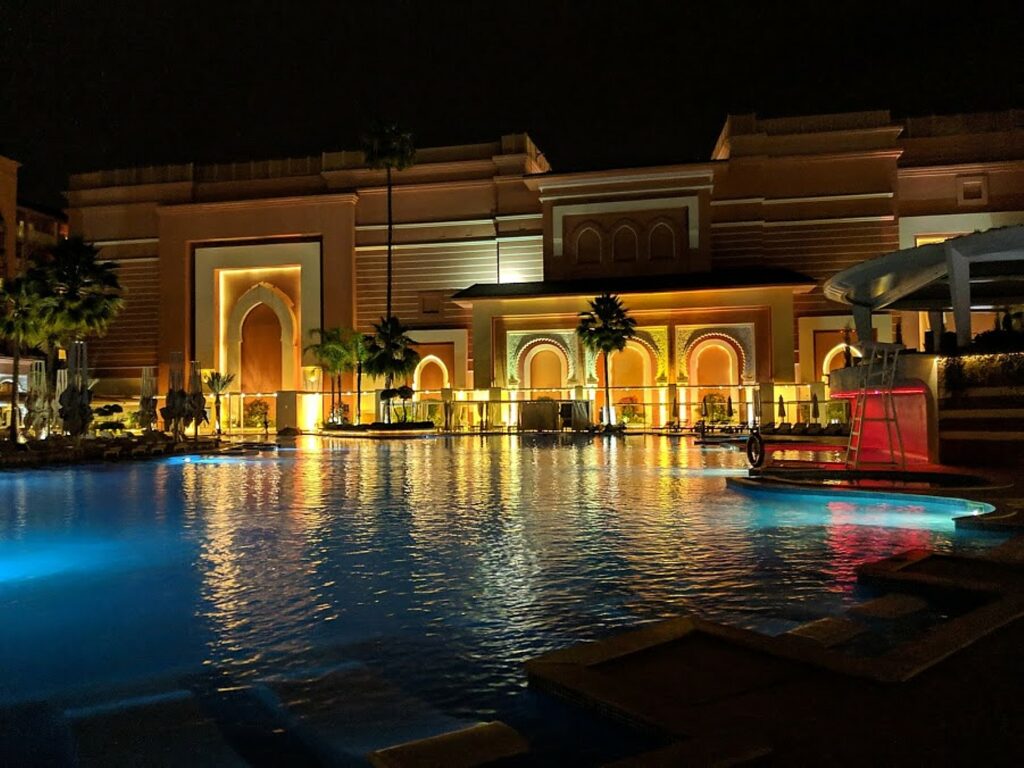
The hotel is a bit garish (it makes me think of the Concord in the Catskills) but actually quite nice. Still, Bill actually apologizes that he couldn’t get us into something more “authentic”. Because of the wedding between British actor Idris Elba and model Sabrina Dhowre (former Miss Vancouver), they had to research over 50 properties before they could get us into Savoy Le Grand Hotel for two nights.
My teammate, Margo, and I are not competing so have the advantage of being able to get advice from the concierge and use hotels.com to book hotels in the places we want to overnight. Even so, it takes from noon to about 5:30 pm to work out an outline for how we will cover the distance – set up the first train ticket from Marrakesh to Fez (we give the concierge the money to buy the ticket) and book hotels in Fez and Gibraltar (another team has gotten names for a traditional riad in Fez and a hotel in Gibraltar which three teams decide to book).
Margo decides to spend an extra day in Porto, Portugal, but I set my sights on Seville, and organize a hotel there and a flight from Seville to Porto (which wouldn’t be allowed if I were competing), so we will travel together from Marrakesh to Fez to Gibraltar and then travel independently until Porto (if we were competing, we would have to do everything as a team).
By 5:30 pm, I still haven’t figured out how to get from Fez to Gibraltar and Gibraltar to Seville, but I am frustrated and angry not actually seeing Marrakesh, and drop everything so we go into the Old City. The other two teams which are following much the same itinerary are content to just wing it once we get to Fez.
Right at the gate to the old city is the famous, five-star La Mamounia Palace hotel – a hotel since 1923, but with a history that extends back to the 12th century. Its magnificent gardens were a wedding gift to Prince Al Mamoun in the 18th century.
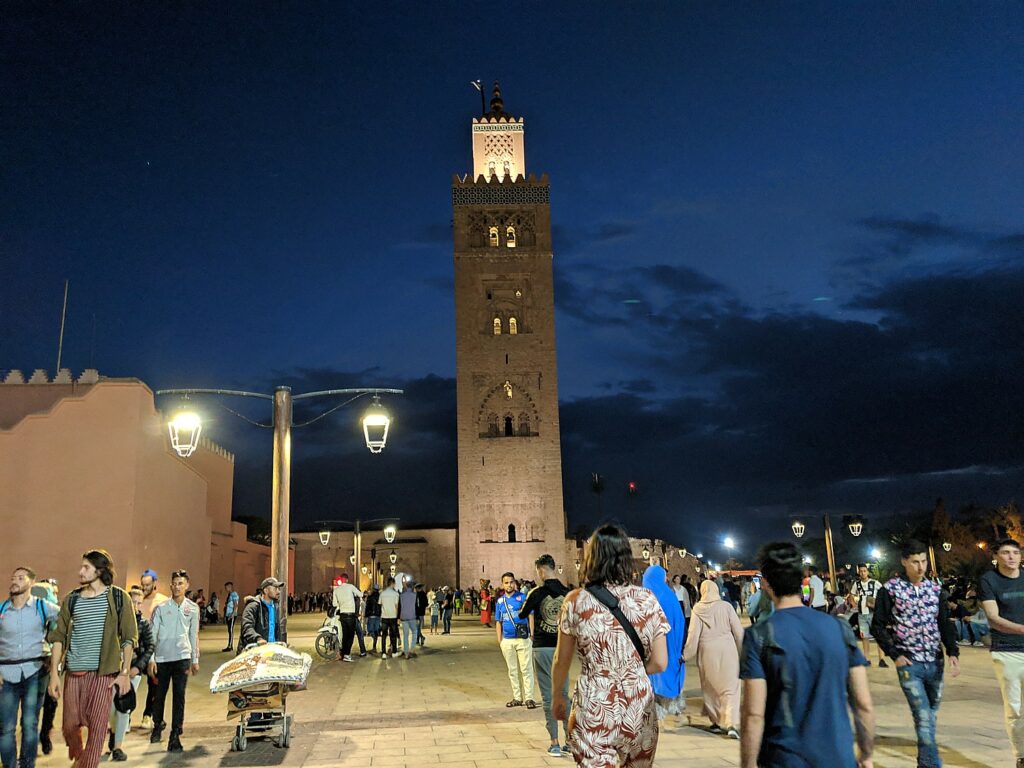
Margo and I walk to the famous Koutoubia Grand Mosque that so dominates the city (It turns out that everything we do could earn scavenge points). The largest mosque in Marrakesh, the Koutoubia is not only its spiritual center but an architectural trend-setter. that was adopted in buildings in Spain (Giralda of Seville) and Rabat (Hassan Tower), which were built in the same period.
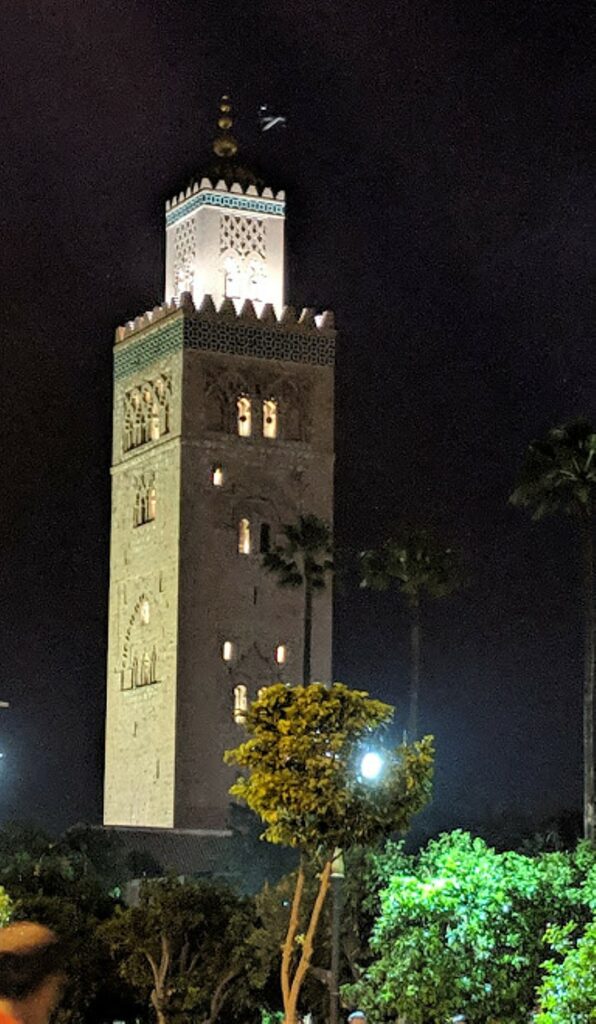
The mosque is ornamented with curved windows, a band of ceramic inlay, pointed merlons, and decorative arches; it has a large plaza with gardens, and is floodlit at night. The minaret tower, standing 253 feet high, has a spire and orbs. The mosque was completed under the reign of the Berber Almohad Caliph Yaqub al-Mansur (1184 to 1199).
Founded in 1062, Marrakesh was once the capital of a vast trading empire that stretched from Toledo to Senegal. You get a sense of this at Marrakesh’s main square, Jemaa el Fna, which I learn, was once a medieval trading square where public executions took place (why it is called the Assembly of the Dead).
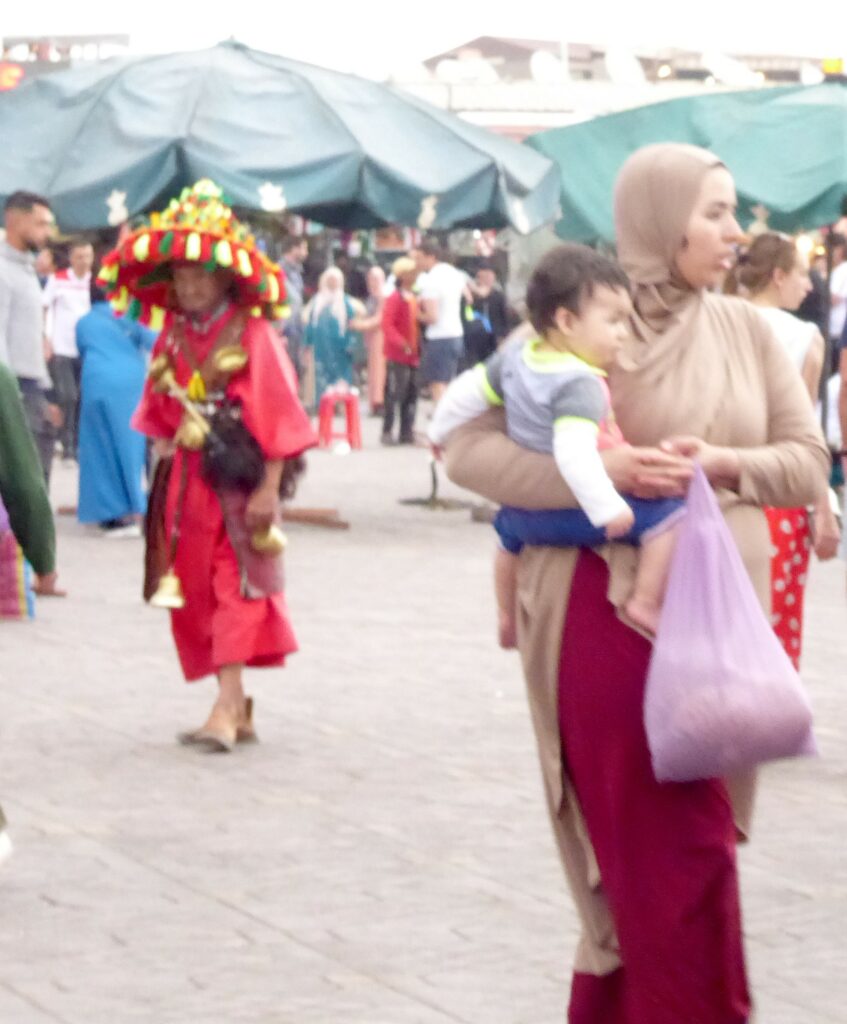
As soon as we enter the massive square, there is a cacophony of sounds, a blur of motion and color. And activity – snake charmers, acrobats, henna artists, musicians, Berbers (who demand money for photo even if you only look at them), merchants hawking every kind of item – snake-oil salesman selling men’s fertility.

There are scores of “restaurants” – stalls, really, with long tables under canvas like picnics, with their representatives with numbered signs identifying their location, recruiting new customers – when one sits down, they serenade in triumph.
The souks radiate off the square with tiny alleyways.
Before it gets too dark, we make our way through the souks to find the Mellah, the Jewish Quarter and the synagogue (which happens also to be one of the scavenges).
We weave through the maze – asking people who point us in a direction (just as we are supposed to do under the Global Scavenger Hunt) – a kindly fellow leaves his stall to lead us down narrow alleyway to Laazama Synagogue, which is still a functioning synagogue but also serves as the city’s Jewish Museum.

After Jews were expelled from Spain by Queen Isabella and King Ferdinand in 1492, Rabbi Yitzhag Daloya came to Marrakesh. He became president of the court and head of the “deportee” community in Marrakesh and founded the “Tzlat Laazama,” Synagogue of Deportees”, shortly after his arrival.
But the Moroccan Jewish community is much older than the Spanish Inquisition– dating back to King Solomon and the Roman period. Marrakesh was founded in 1062 by Joseph Ibn Tasifin, ruler of the Halmorabidim, who allowed Jewish settlement in the city. The Jewish community was “renewed” in 1269, headed by Rabbi Yahuda Jian, originally from southern Spain. The Atlas Jews remained the majority of the community even after the Jews from Spain and Portugal settled in Marrakesh.
The situation changed in the 16th century when Marrakesh became a major center for Marranos (secret Jews) who wished to practice Judaism openly. Spanish and Portuguese Marrakesh Jews lived in their own neighborhoods until all local Jews, some 35,000, were collected by order of the King, in 1557, and resettled in the Mellah (a walled community). In the 19th century, the population increased in the Mellah after refugees from the Atlas Mountains arrived, becoming the largest Jewish community in Morocco. At one time, there were 40 synagogues here.
The synagogue is beautifully decorated with tile, a courtyard ringed with study rooms, a music room, living quarters. There is a video about history of Jewish community in Marrakesh. The photos on the walls are interesting – the faces of the Moroccan Jews are indistinguishable from the Arab Moroccans.
Moroccan Jews have also left the country – the Moroccan Jewish Diaspora counts more than 1 million members in four corners of the world, “a diaspora that continues to cultivate ties to their homeland, Morocco.” Indeed, we come upon a woman with her sister-in-law and mother who left Marrakesh first for Casablanca and now lives in Paris; her brother is still a member of the synagogue’s leadership – she shows us his chair. Her grandfather is buried in the nearby Jewish cemetery.
From the synagogue, we walk to the Jewish cemetery, Beth Mo’ed Le’kol Chai, which should have been closed, but the guard lets us in.

Founded in 1537, the cemetery spans 52 hectares and is the largest Jewish burial site in Morocco, with some 20,000 tombs including tombs of 60 “saints” and devotees who taught Torah to the communities of Marrakesh and throughout Morocco.
The arrangement of the graves is “unique” to the city of Marrakesh. There is a children’s section, where 7000 children who died of Typhus are buried; a separate men’s section and a woman’s section while around the perimeter are graves of the pious, the judges and scholars of the city who are believed to provide protection for all those buried.
Margo hails a taxi to head back to the hotel, and I walk back to the main square through the markets (the tricky part is less about getting lost than avoiding the scooters that speed through the narrow alleyways), and get the real flavor of this exotic place and dusk turns to darkness and the neon-colored lights come on.

Here you can see a huge variety of Moroccan craftsmen and tradesmen, organized by profession, under a roof of reeds, hawking leather goods, fabrics, kettles, pottery. The Dyers’ Souk, has colorful skeins of wool hanging out to dry on its walls, while the Blacksmiths’ Souk (souk Haddadine) displays a wide variety of metalwork.

Back in the bustling Jemaa el Fna square, I see a crowd of men gathered around one fellow with a lizard, selling a miracle cure. When I ask a fellow what it is about, he grins and I get the idea. No different than the snake-oil salesmen of old.
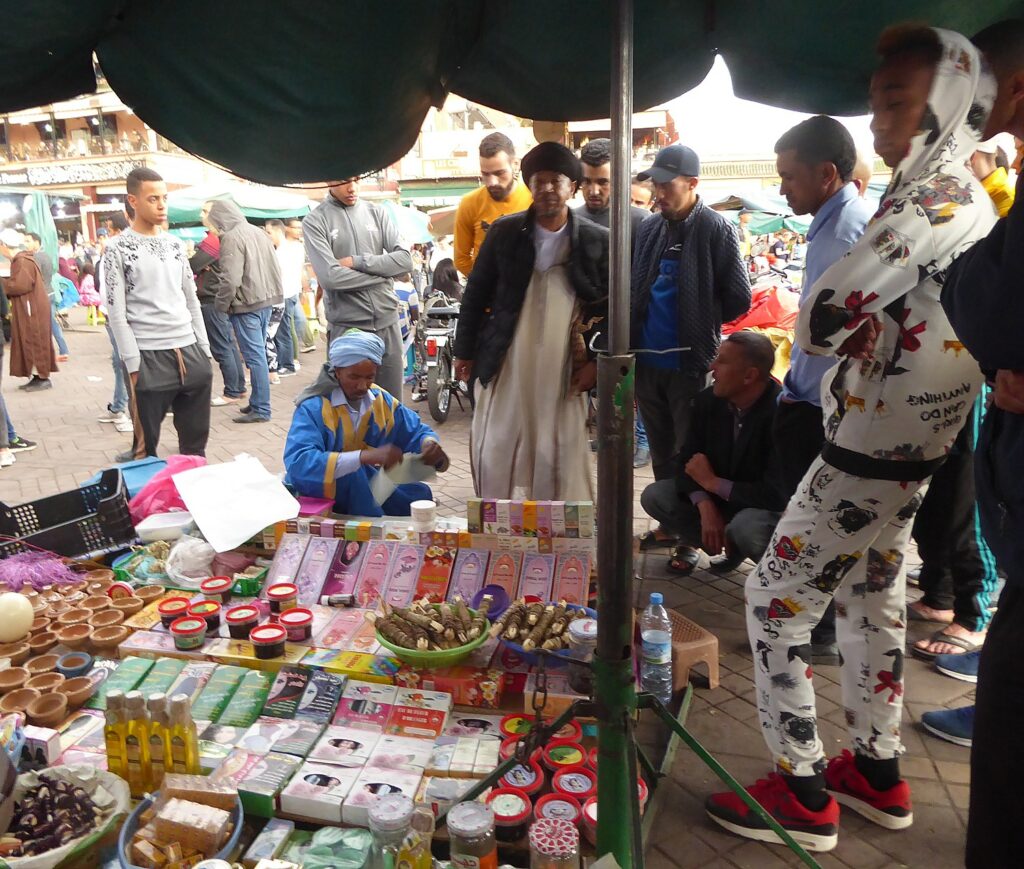
It’s dinner time, neon lights have come on, and I go to the section of the square where there are dozens of outdoor restaurants. Guys wave a placard with their stall number which are their ID and do a sales pitch (“Remember #1, Remember 35”, “Air-Conditioned!” they say with a grin). Then when you stop, fellows come by and sing to draw in customers. It is all very good natured. I find a stall to have dinner – seated on a bench with others who have come here from around the world and local neighborhoods.
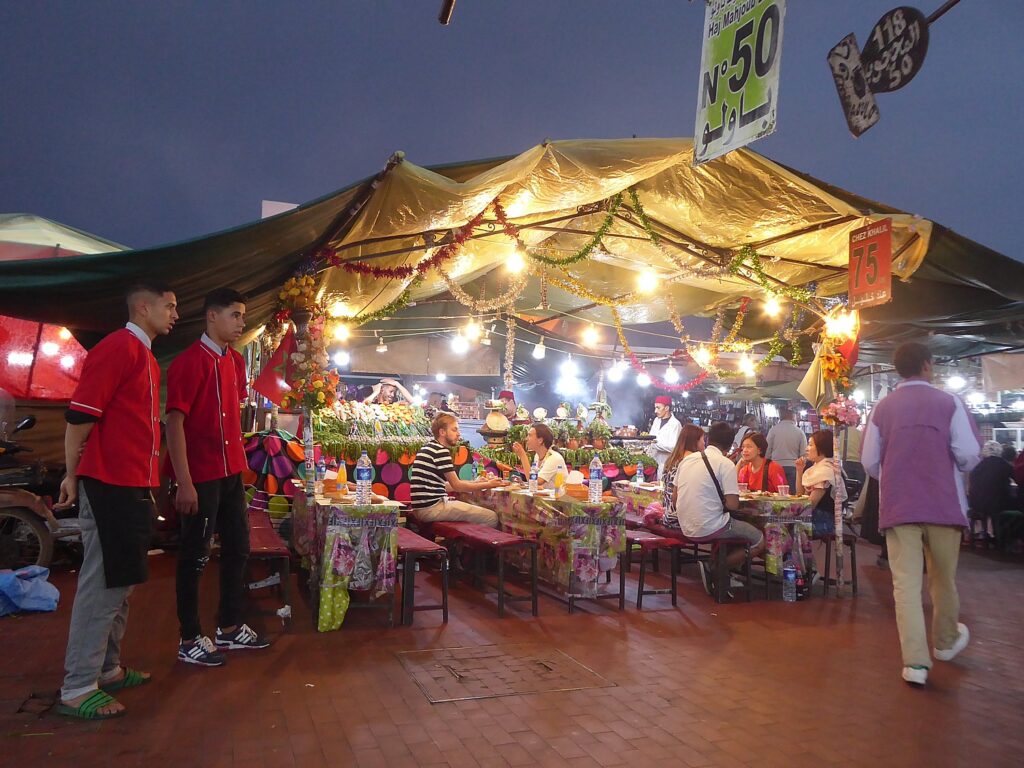
It should be noted that Marrakesh has bike share, bike lanes, pedestrian crossings, is clean, with lots of police and auxiliary, striking new buildings, and the people are very helpful and hospitable.
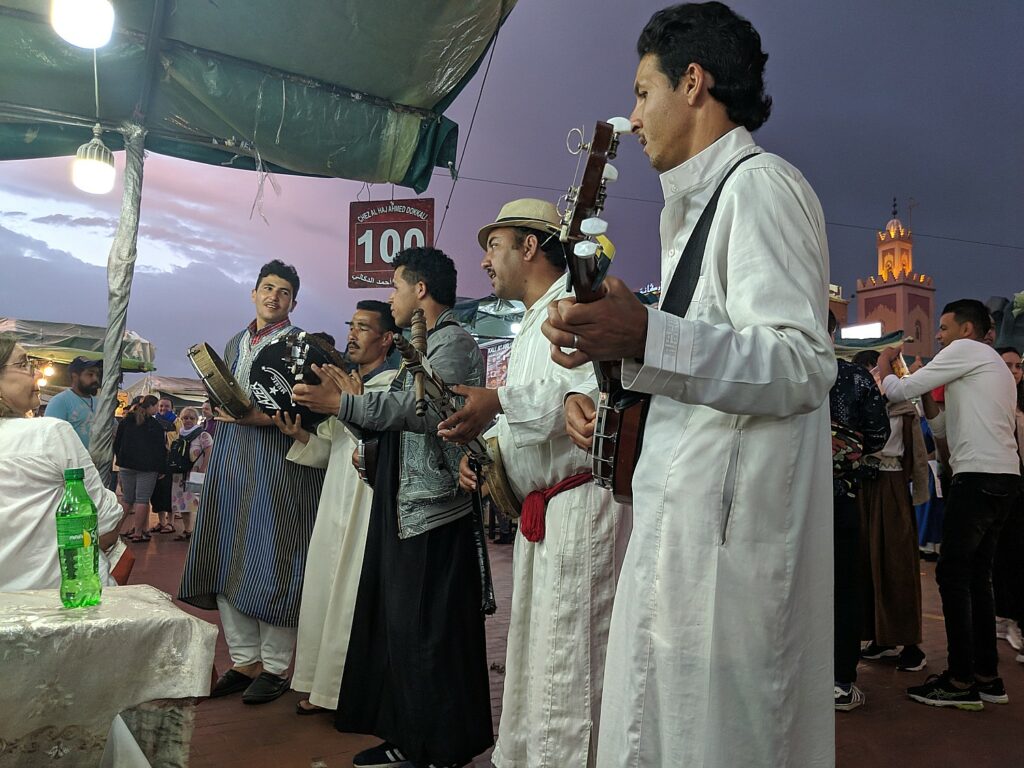

Marrakesh, a thousand-year old city, has just been designated African Capital of Culture 2020, a a showcase of today’s urban Africa, highlighting the diversity of African culture.
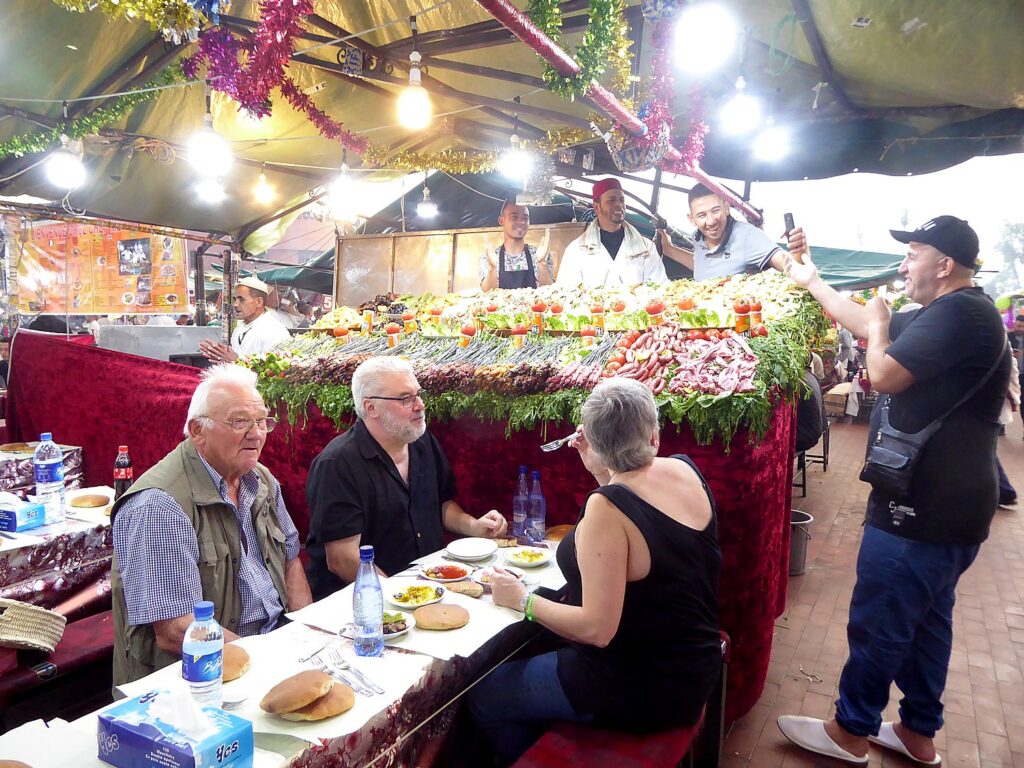
The next day we are up at 4:30 am, breakfast is delivered at 5 am, and we take a five-minute cab ride to a gorgeous train station, to catch the 6 am train, riding in a first-class compartment for a wonderful 6 ½ hour trip to Fez.
The Global Scavenger Hunt is an annual travel program that has been operated for the past 15 years by Bill and Pamela Chalmers, GreatEscape Adventures, 310-281-7809, GlobalScavengerHunt.com.
________
© 2019 Travel Features Syndicate, a division of Workstyles, Inc. All rights reserved. Visit goingplacesfarandnear.com, www.huffingtonpost.com/author/karen-rubin, and travelwritersmagazine.com/TravelFeaturesSyndicate/. Blogging at goingplacesnearandfar.wordpress.com and moralcompasstravel.info. Send comments or questions to [email protected]. Tweet @TravelFeatures. ‘Like’ us at facebook.com/NewsPhotoFeatures
